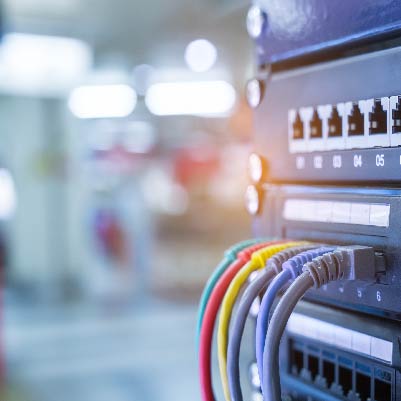Technology
Powerful and reliable technology you can trust.

Customer Needs Drive Everything We Do
The technology behind all of Biamp’s products is designed with innovation and the customer in mind. We invest considerable time, resources, and expert-level industry knowledge into each product we develop, and we want you to feel confident that the Biamp products you choose for each installation will work as expected. We support and develop technologies that meet your AV and networking needs now and well into the future.

Audio Video Bridging/Time Sensitive Networking is a media transport platform designed to transfer synchronized, low latency audio and video streams over Ethernet networks.
A collection of open IEEE 802.1 standards, AVB/TSN is Biamp’s preferred method for transporting media data across a network. It offers considerable advantages over other protocols, including deterministic delivery of streams, precise time synchronization for automated lip sync, and bandwidth reservation and automated Quality of Service (QoS) setup to prevent traffic flooding.
With an AVB/TSN backbone, media streams can travel throughout your facility over the corporate Ethernet network side-by-side with other forms of data without compromising network integrity. AVB/TSN’s provision for stream reservation is one of the pillars that make converged networks possible. It’s this reservation protocol that prevents media content (i.e. video) from choking off bandwidth for other services running over the same port/switch. With this level of scalability, you can expand distribution of digital media by just adding endpoints whenever and wherever they’re needed.
AVB/TSN offers two fundamental advantages over other Ethernet implementations when deploying video networks. For integrators, it offers automatic device discovery, enabling rapid configuration and commissioning of projects. For the end user, AVB/TSN’s innate low latency and precise time synchronization enable deterministic delivery of both audio and video, which is critical for lip sync.

Networked video has become a professional must-have. However, the challenge remains for ensuring the media streams arrive at the right place, at the right time.
Network-based topologies are inherently more flexible than point-to-point offerings, and these increasingly robust networks now have the capacity to transfer multiple data streams concurrently with audio and video streams.
AVB/TSN is Biamp’s preferred method for transporting media data across a network. It offers considerable advantages over other protocols, including deterministic delivery of streams, precise time synchronization for automated lip sync, and bandwidth reservation and automated Quality of Service (QoS) setup to prevent traffic flooding. All of these capabilities are of particular importance with regard to video due to the bandwidth requirements of HD/UHD video streams.
Layered on top of the transport mechanism is the video compression algorithm. Pro AV requires low latency, visually lossless transport at very low compression ratios to meet the requirements for lip sync in live settings. These requirements are typified by more mature, less complex algorithms having well-shaped constant bit rate streams, which are some of the reasons why we chose M-JPEG as the algorithm for TesiraLUX. For more information regarding M-JPEG and compression in general, see our blog post.
We also recognize that integrators need to be able to manage and adjust video bandwidth based upon their customers’ needs. Tesira software allows you to adjust the maximum resolution, minimum frame rate, and compression ratio of each video stream, allowing you to custom-tailor the bandwidth for each of the different content types that you plan to distribute over the network. The result is TesiraLUX’s robust, automated lip sync management that strives to match audio and video synchronization within 20 milliseconds or less. That means content and conversations are both visually lossless and perfectly in time.

Biamp has built its reputation on great sound. It’s been our business for 40+ years. Our technology allows conversation to flow naturally and be heard, whether you are communicating on a conference call, in a lecture hall, or in a courtroom.
Regardless of the application, the goal of professional audio installations is natural, intelligible sound. Great audio has been one of our core tenets for more than 40 years. Sophisticated, adaptive DSP is at the heart of what Biamp does and what we deliver. With completely open programming and no restrictive predetermined signal flows, we offer a powerful set of tools for creating innovative and efficient audio systems. From a single training room to a campus full of lecture halls to a cutting-edge multipurpose auditorium, we have the technologies and expertise to make each installation a success.
AEC technology eliminates acoustic echoes during conference calls, improving call clarity for individuals on the far end of the call. Any changes to the room environment—whether it’s the repositioning of a microphone or the noise of someone shuffling papers—require AEC processing to react quickly and accurately in order to maintain clear communication. That’s why our industry-leading AEC is so critical; it results in unmatched call clarity and intelligibility, even in dynamic environments.
Typically, gathering spaces are not designed with good acoustics in mind. Sometimes it’s the height of a ceiling or the surface of a wall. At other times it’s ambient noise from HVAC systems, construction, or buses passing. The good news is that whatever the obstacle, Biamp’s DSP expertise guarantees incredible results. Our embedded technologies take a myriad of variables into account, and automatically modify signals so you don’t have to. Biamp SpeechSense™ and AmbientSense™ technologies more accurately identify desired signals for processing, allowing the system to adjust volume in real-time, and ensure proper output.

Networked Media Systems (NMS) are the natural evolution away from isolated systems, and are designed to maximize system resources while simplifying system administration. Our Tesira and Vocia DSP platforms support a number of different NMS configurations, allowing us to effectively support a wide range of installation use cases.
The concept of a Networked Media System is simple. It’s any audio and/or video equipment that communicates via an organization’s Ethernet network. Some of the benefits are:
- Cost Savings—Simplified system design, installation and operation
- Efficiency—Ability to share processing resources over the network
- Flexible methodology—Flexibility to reconfigure the system without moving hardware
- Scalability—Easier expansion into new areas and buildings
- Sustainability—Reduced need for cable and equipment, making installations better for the environment
Networked Media Systems can support multiple types of solutions simultaneously. For example, a facility could have paging throughout a floor or building, conferencing in the meeting rooms, and sound reinforcement in the auditorium, all operating simultaneously and running on the corporate network. NMS leverages your existing network infrastructure, which results in cost savings and ease of installation.

Beamforming microphones are great, but they’re inherently static. Essentially the beams determine where people should be. We think this is the wrong way around. Instead, we think people should determine where the beams are directed.
A Biamp room emphasizes the user experience—not just with the technology itself, but also with how people interact with it. That’s why we give people the ability to move around the room as they see fit, not as the microphone dictates.
Beamtracking technology differs from beamforming in that it allows a single microphone to cover a wide area with little to no setup, since the microphone identifies and locks to a signal source—even if the person speaking is moving around. Our beamtracking microphones also intelligently mix conversations from around the table, allowing far-end conference participants to experience a more natural-sounding conversation. The patented interactions between our AEC and beamtracking algorithms dynamically adjust the output in real-time to ensure far-end echo is minimized.

Ambient Noise Compensation (ANC) technology allows the volume of overhead pages and announcements to be adjusted automatically up or down based on real-time background (ambient) noise levels.
The ability to hear overhead pages clearly is vital in both emergency situations and other time-sensitive scenarios, such as gate change announcements in an airport. Ambient Noise Compensation (ANC) ensures that your messages will be heard over background noise during loud or busy times, without being disruptive during quieter periods.
ANC involves deploying “sensing” microphones in noisy areas; the signal levels transmitted by the microphone are analyzed by the DSP, and the output level is adjusted automatically. Only one “sensing” microphone is required for ANC to work, however, in some cases more sensing microphones provide better coverage. For example, one microphone may be sufficient for a medium sized foyer, while having multiple sense points would be preferable in a lengthy corridor.
ANC technology is very effective in noisy environments such as rail stations and airports, or even office environments where noise levels vary between floors and departments. ANC is also helpful in quiet environments such as hospitals. If patients are resting and the floor is quiet, then the overhead pages will not be harsh or jarring.

Vocia offers software-based zoned paging, allowing facility operators to send targeted pages to specific areas affected by the information, without disrupting unaffected areas or costly rewiring.
Many facilities have their paging systems set up as one large “all call” zone covering the entire building. As a result, everyone hears every overhead page, which can be disruptive and cause people to ignore pages. Vocia lets you pinpoint messages and announcements only where they’re relevant—in a building, on a particular floor, or even in a hallway. We call it “narrowcasting,” and it helps staff take in relevant information more effectively, while providing a quieter and less disruptive environment for unaffected people in the building.
Vocia’s paging zones are created entirely within the software—logically, not physically. That means zones can be added or changed easily, without having to relocate hardware. Since Vocia is an Ethernet-based system, there’s no need for special cabling or “homerun” wiring. Endpoints can be installed anywhere on the system, resulting in a substantially lower total cost of ownership.
Zoned paging is particularly beneficial in medical facilities. A quieter healthcare environment has a number of key benefits, including fewer patient-care days, shorter staff response times, and more efficient operations. By using location-based pages and nurse calls, hospitals can create cost-effective, quiet facilities by preventing unnecessary messages from playing inside or near patient rooms. Installing Vocia’s Automatic Noise Compensation (ANC-1) device near patient rooms will automatically adjust output levels to ensure messages are intelligible without being overly loud. With Vocia, overhead paging is not only more efficient, but it’s more intelligent—contributing to a quieter, patient-centered healing environment.

Our Vocia platform includes several options for comprehensive system monitoring and reporting that can be customized based on your project’s needs.
Modern Emergency Communications Systems (ECS) have significant requirements for system monitoring and fault detection and reporting. For Vocia, those fault conditions can range from automated emergency notifications to individual components going offline. The centerpiece of our monitoring is our software dashboard, which allows quick and easy access to diagnostics, system health information, status, usage, audio levels, and more. System alerts are displayed on the dashboard, and can be automatically emailed to a facility’s command center or relevant individuals when customer-specified fault conditions are triggered.
Vocia uses distributed networking with system intelligence residing in each local device. Should a device fail, only that device is impacted, and the remainder of the system will still function normally. Vocia’s internal monitoring feature immediately reports any failure so corrective measures can be taken. There are also redundancies built into every major device, such as amplifiers and the MS-1e messaging processor. In the event of device failure, it is backed up by another device within the network.
For speaker runs, Vocia’s end-of-line devices test and report on speaker line integrity with Vocia amplifiers. This allows you to monitor and receive notifications if one or more loudspeakers are not receiving a signal from a Vocia amplifier, which is critical during times of emergency. If an error is detected, it will be displayed in the Vocia software. This is particularly helpful for large facilities such as airports and rail stations, which tend to have numerous long speaker runs.
Vocia also interfaces with building systems such as fire panels and security systems. The LSI-16 was specifically developed to connect to a fire alarm and put the system into emergency mode when the fire alarm is triggered. However, in many situations, the fire alarm bell is no longer the end-all-be-all for emergency notification. Recent situations have made the authority having jurisdiction (AHJ) realize that numerous systems must be employed, and in different ways, depending on the nature of the emergency. Alarms are never deactivated or ignored; instead verbal direction is now allowed (in predefined ways) to take precedence over the alarm that may be occurring at the same time. These are all intelligent and automated functions that Biamp has researched and built into Vocia to address and meet the latest standards in emergency communications, whether deemed critical now or in the future.
Contact Us.
Our sales and support teams are ready to help.
Contact us today.
general information
Email:
moc.pmaib@ofnipmaibUS Phone:
1 800 826 1457International Phone:
+1 503 641 7287
technical
supportEmail Biamp Support:
moc.pmaib@troppusUS Phone:
1 877 BIAMP XO (1 877 242 6796)International Phone:
Choose Your RegionTech Return Authorization Request Cornerstone - Online Tech Support
orders
supportEmail:
moc.pmaib@sredroGlobal Phone:
1 800 826 1457 opt 1International Support:
Choose your RegionOrder & shipping status, availability
Orders Return Authorization Request




